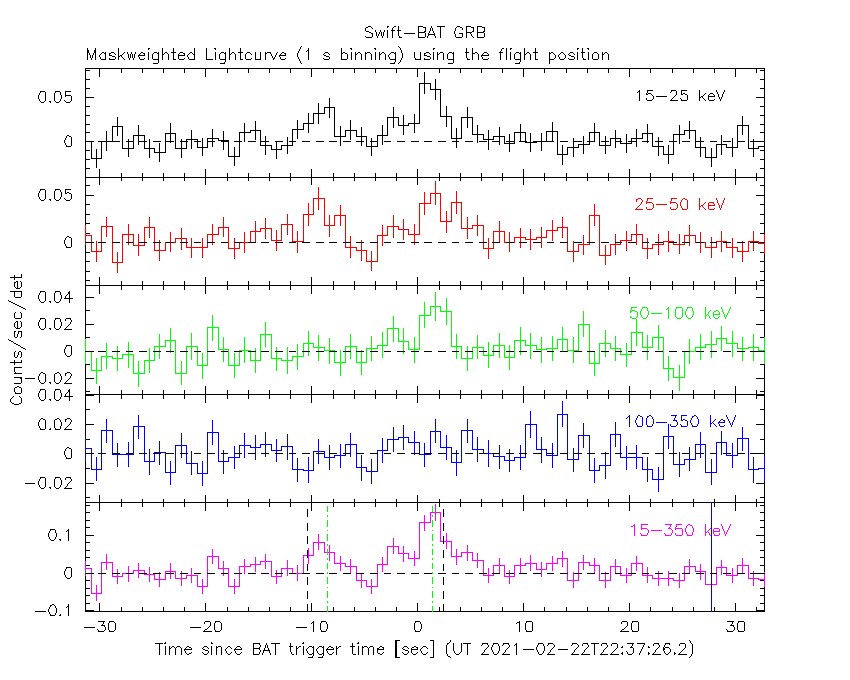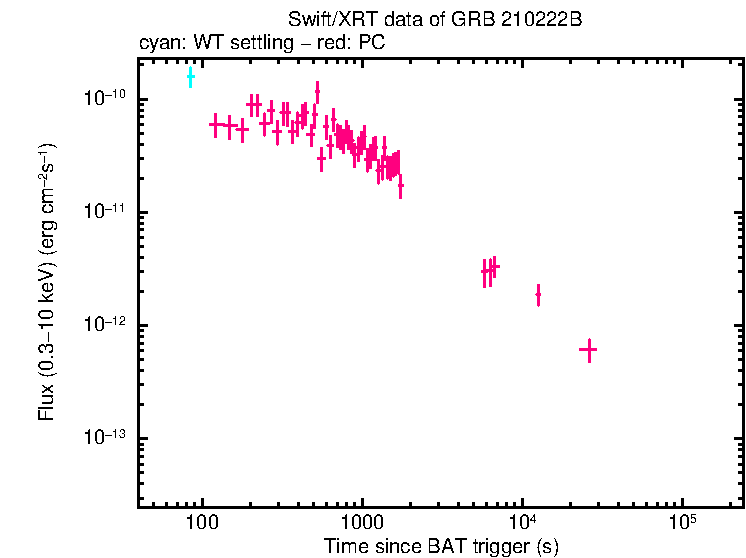
J.D. Gropp (PSU), K.L. Page (U. Leicester) and M.H. Siegel (PSU) for the Swift team
At 22:37:26 UT, the Swift Burst Alert Telescope (BAT) triggered and located GRB 210222B (trigger=1034325) (Gropp et al. GCN Circ. 29545). Swift slewed immediately to the burst. At the time of the trigger, the initial BAT position was 155° from the Sun (11.9 hours East) and 66° from the 79%-illuminated Moon. Table 1 contains the best reported positions from Swift, and the latest XRT position can be viewed at http://www.swift.ac.uk/xrt_positions.
Gropp et al. (GCN Circ. 29545) reported the discovery with UVOT of an optical afterglow. Mong et al. (GCN Circ. 29550) reported the position from Gravitational-wave Optical Transient Observer for the optical afterglow of this GRB. Fernandez et al. (GCN Circ. 29552) determined a redshift of 2.198 from VLT/FORS2. Table 2 is a summary of GCN Circulars about this GRB from observatories other than Swift.
Standard analysis products for this burst are available at https://gcn.gsfc.nasa.gov/swift_gnd_ana.html.
As reported by Ukwatta et al. (GCN Circ. 29561),
the BAT ground-calculated position is RA, Dec = 154.631, -14.946 deg which is RA(J2000) = 1
The BAT light curve (Figure 1) showed a two peaked structure with a duration of about ~20 s.
The time-averaged spectrum from T-11.37 to T+2.72 s is best fit by a simple power-law model.
The power law index of the time-averaged spectrum is 2.37 ± 0.33.
The fluence in the 15-150 keV band is 3.4 ± 0.7 x 1
The results of the batgrbproduct analysis are available at https://gcn.gsfc.nasa.gov/notices_s/1034325/BA/.
Analysis of the initial XRT data was reported by Page et al. (GCN Circ. 29560). We have analysed 6.2 ks of XRT data for the Swift-BAT-detected burst GRB 210222B, from 111 s to 63.2 ks after the Swift-BAT trigger. The data are entirely in Photon Counting (PC) mode.
The light curve (Figure 2) can be modelled with an initial power-law decay with an index of α=0.19 ± 0.16, followed by a break at T+827 s to an α of 1.30 (+0.12, -0.08).
A spectrum formed from the PC mode data can be fitted with an absorbed
power-law with a photon spectral index of 1.98 (+0.15, -0.14). The
best-fitting absorption column is 1.4 (+0.5, -0.4) x 1
The Swift/UVOT began settled observations of the field of GRB 210222B 101 s after the BAT trigger
(Siegel and Gropp GCN Circ. 29559).
A source consistent with the XRT position is detected in the initial UVOT exposures.
Table 3 gives preliminary
magnitudes using the UVOT photometric system
(Breeveld et al. 2011, AIP Conf. Proc., 1358, 373).
No correction has been made for the expected extinction in the Milky Way
corresponding to a reddening of

Figure 1. The BAT
mask-weighted light curve in the four individual and total
energy bands. The units are counts

Figure 2. The XRT light curve.
Any data from a crosshatched region are not included in the fit.
| RA (J2000) | Dec (J2000) | Error | Note | Reference |
|---|---|---|---|---|
| 1 |
-14°55'55.1" | 0.42" | UVOT-refined | Siegel and Gropp GCN Circ. 29559 |
| 1 |
-14°55'54.3" | 1.5" | XRT-final | UKSSDC |
| 1 |
-14°55'54.1" | 1.4" | XRT-refined | Page et al. GCN Circ. 29560 |
| 1 |
-14°56'45.7" | 2.0' | BAT-refined | Ukwatta et al. GCN Circ. 29561 |
| Band | Authors | GCN Circ. | Subject | Observatory | Notes |
|---|---|---|---|---|---|
| Optical | Hu et al. | 29546 | BOOTES-1 optical afterglow detection | BOOTES-1 | detection |
| Optical | Strausbaugh and Cucchiara | 29547 | LCO Optical Afterglow Detection | LCO | detection |
| Optical | Mong et al. | 29548 | GOTO confirmation of afterglow detection | Gravitational-wave Optical Transient Observer | detection |
| Optical | Perley | 29549 | Liverpool Telescope optical detection | Liverpool Telescope | detection |
| Optical | Mong et al. | 29550 | GOTO confirmation of afterglow detection (correction to GCN29548) |
Gravitational-wave Optical Transient Observer | detection |
| Optical | Zhu et al. | 29551 | NEXT early optical afterglow observations |
Xinjiang Astro. Obs. | detection |
| Optical | Fernandez et al. | 29552 | Redshift from FORS2/VLT | VLT/FORS2 | redshift |
| Optical | Lipunov et al. | 29554 | MASTER OT observation | MASTER | |
| Optical | Jelinek et al. | 29557 | FRAM-ORM afterglow detection | FRAM | detection |
| Optical | Zheng and Filippenko | 29558 | KAIT Optical Upper Limit | KAIT | upper limits |
| Optical | Gokuldass et al. | 29562 | VIRT optical detection | Virgin Island Robotic Telescope | detection |
| Optical | Belkin et al. | 29563 | Zeiss-1000 of Koshka observatory, optical observations |
Koshka Obs. | detection |
| Optical | Hosokawa et al. | 29565 | MITSuME Akeno optical upper limits | MITSuME Akeno | upper limits |
| Optical | D'Avanzo et al. | 29567 | REM observations of the optical/NIR afterglow |
REM | detection |
| Optical | Gupta et al. | 29569 | 1.3m DFOT Optical upper limit | DFOT | upper limits |
| Optical | Klotz et al. | 31753 | TAROT Reunion observatory optical light curve |
TAROT | light curve |
| Filter | Exp(s) | Mag | ||
|---|---|---|---|---|
| white | 101 | 250 | 147 | 16.89 ± 0.03 |
| v | 588 | 608 | 19 | 16.80 ± 0.17 |
| b | 515 | 534 | 20 | 17.24 ± 0.12 |
| u | 259 | 508 | 246 | 16.82 ± 0.04 |
| w1 | 639 | 1793 | 124 | >18.8 |
| m2 | 614 | 1606 | 78 | >20.1 |
| w2 | 564 | 1732 | 136 | >19.1 |
Table 3. UVOT observations reported by Siegel and Gropp (GCN Circ. 29559). The start and stop times of the exposures are given in seconds since the BAT trigger. The preliminary detections and 3-σ upper limits are given. No correction has been made for extinction in the Milky Way.
March 14, 2022